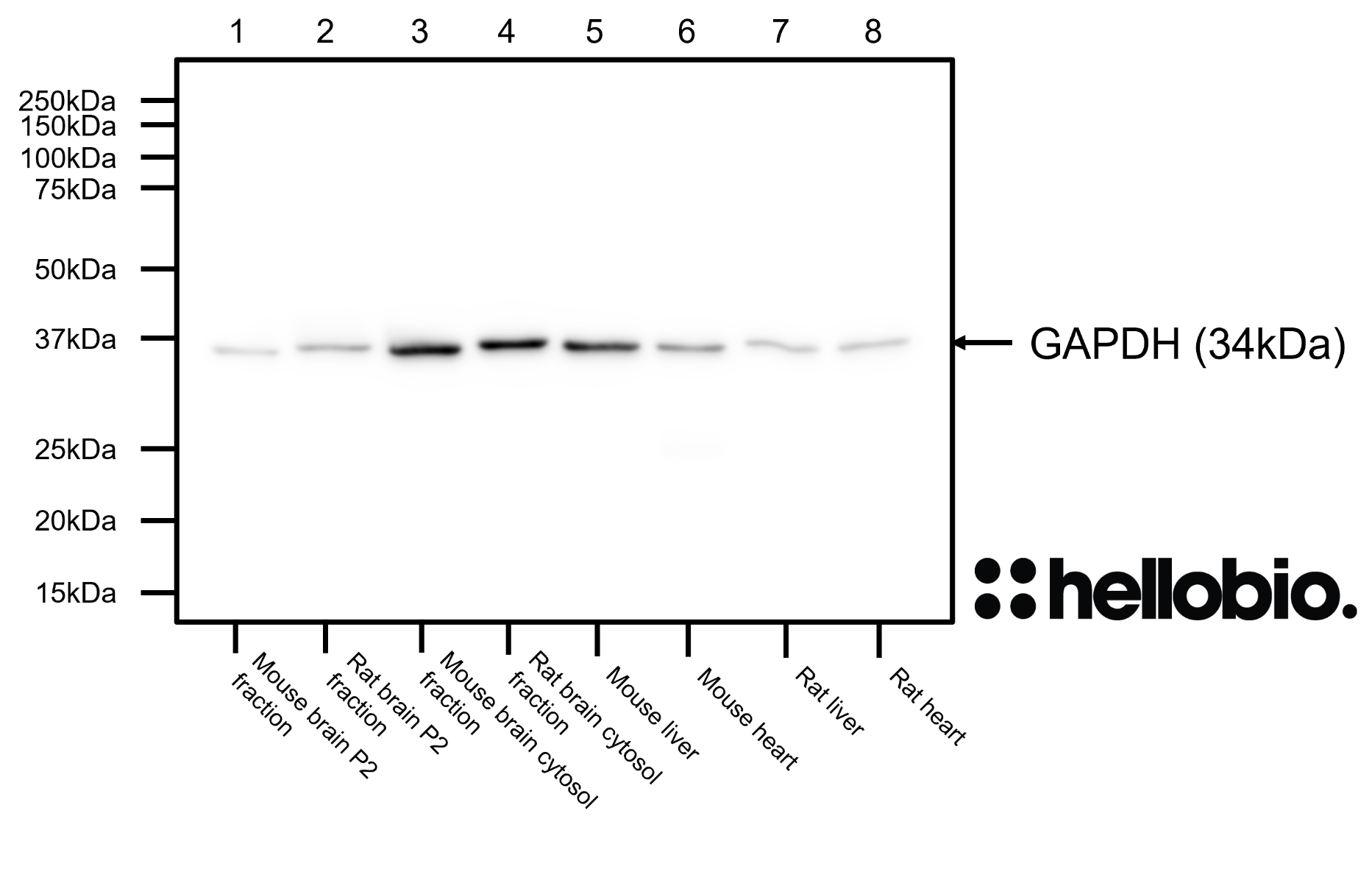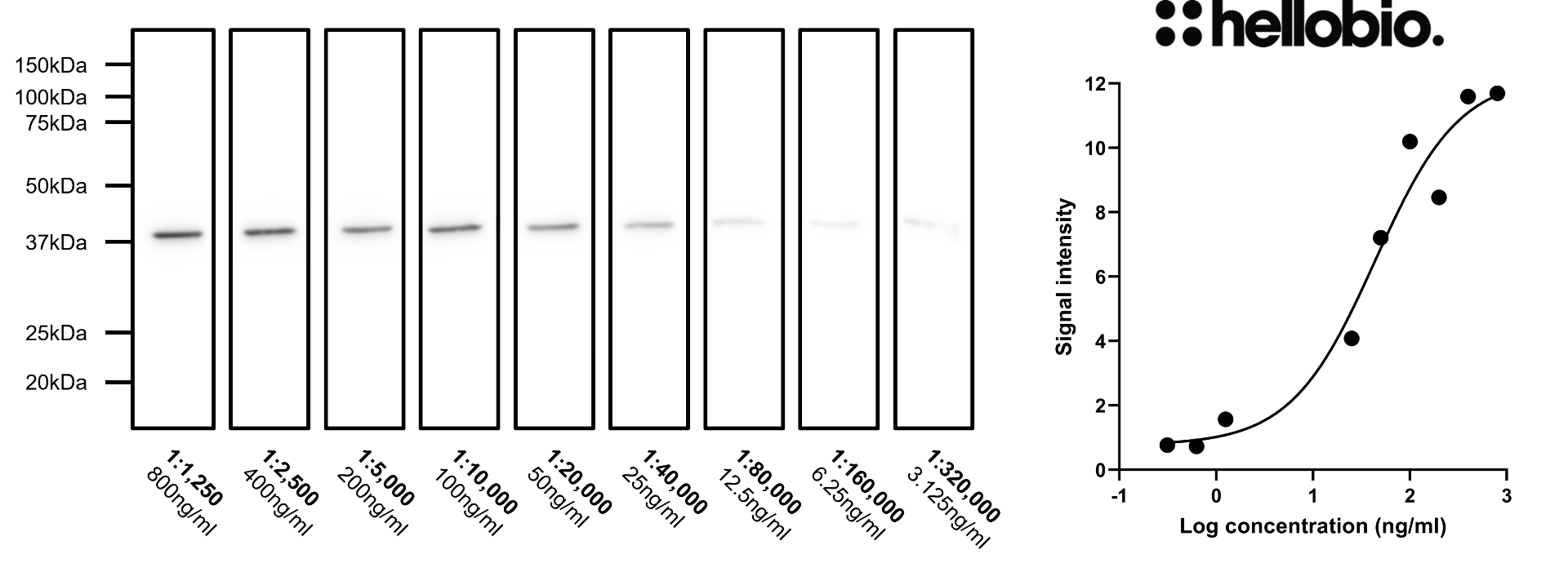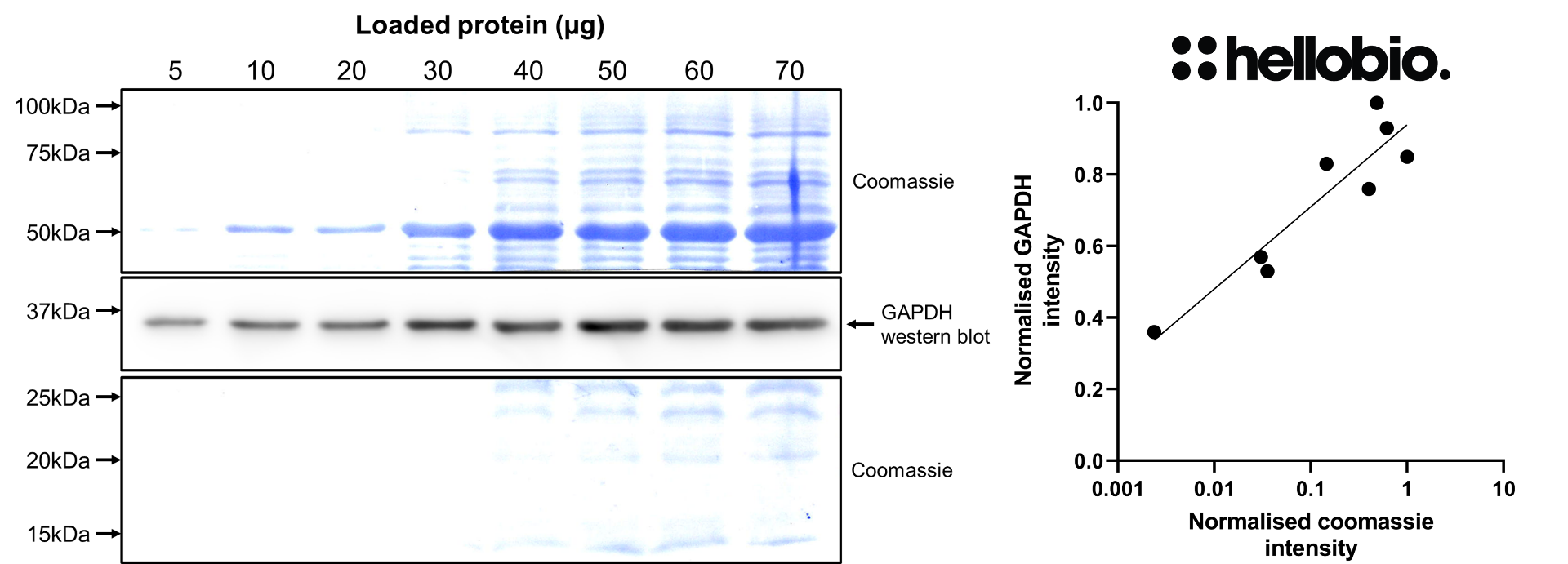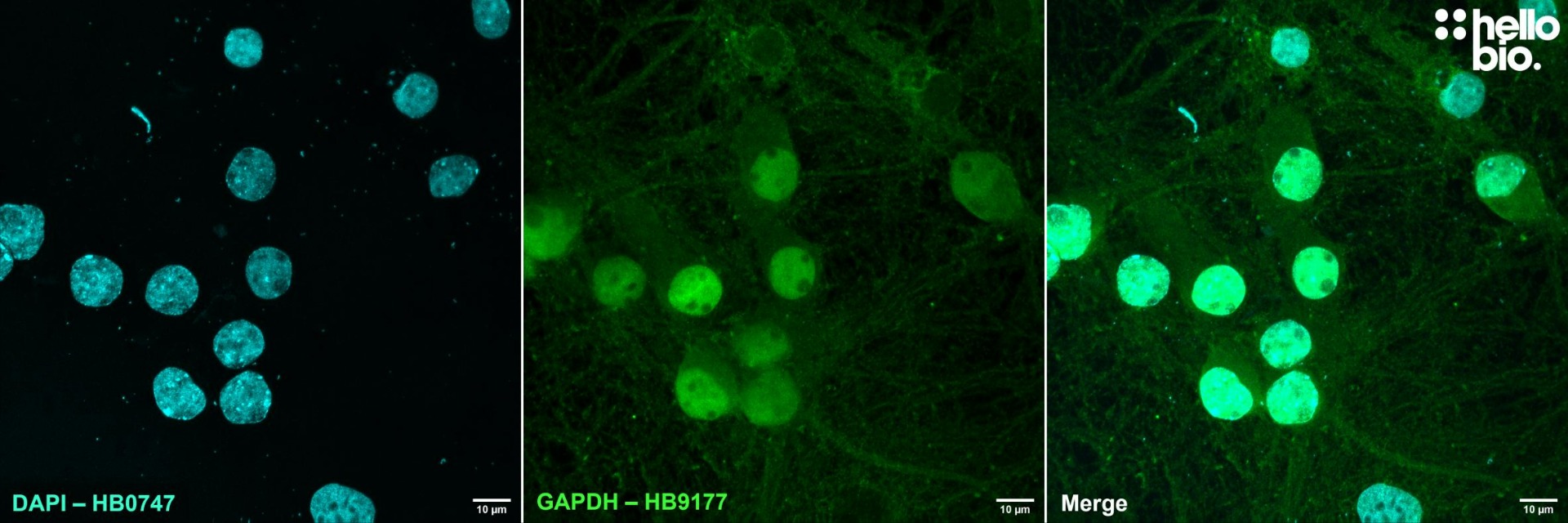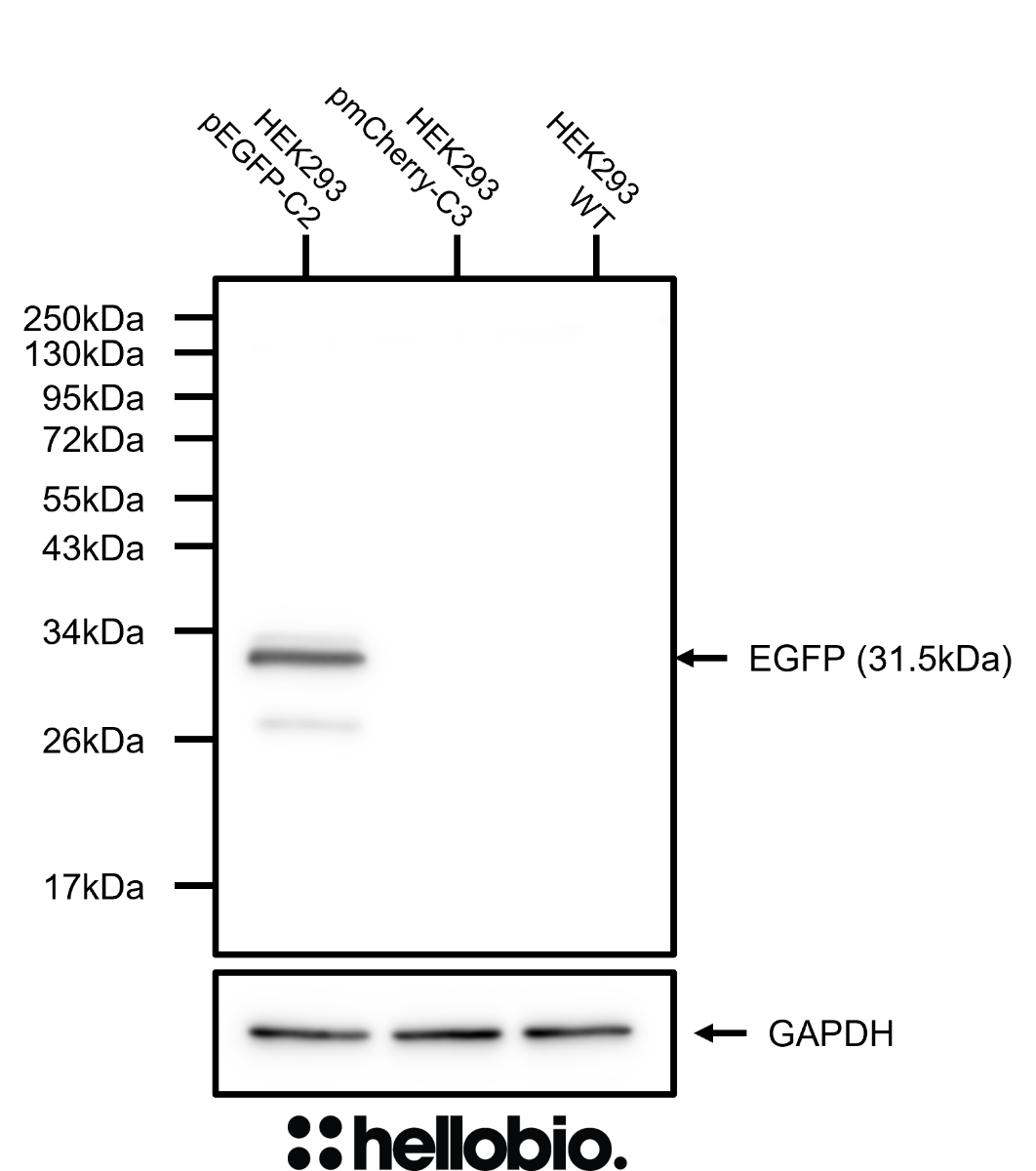![]()
|
Figure 1. GAPDH expression in various tissue lysates and preparations. HB9177 revealed a single band of size 34kDa present in all samples with a strong signal to noise ratio. Method: mouse brain and rat brain membrane (P2) and cytosol fractions were prepared following previous work (Molnar et al., 1993. Neuroscience 53:307-326) from freshly collected adult brains. Other tissue lysates were prepared following established protocols from freshly dissected tissue (see our guide on WB sample preparation). Samples (20µg / lane) were loaded onto a 12% acrylamide gel alongside a protein ladder (BioRad Precision Plus dual colour, 1610374) before being run at 60V for 30 minutes followed by 120V for 90 minutes. Wet transfer to a PVDF membrane was completed in 90 minutes using 400mA. The membrane was blocked for 2hrs in 5% non-fat dry milk before being incubated overnight at 4°C in HB9177 at a 1:2000 dilution (0.5µg/ml). Following washing the membrane was incubated in secondary antibody (1:10,000 dilution, Polyclonal goat anti-mouse HRP conjugated, Sigma Aldrich A3682) for 2hrs. For more detail please see our Western blotting protocol. Detection was accomplished using Clarity Western ECL substrate (BioRad, 1705061) and a Licor Odyssey Fc imaging system (ECL channel: 10 min exposure, 700nm channel: 30 sec exposure). |
![]()
|
Figure 2. Concentration response of HB9177 staining in a rat brain cytosol preparation. HB9177 shows consistent results with low background at dilutions as low as 1:320,000 (3.125 ng/ml). Method: cytosol fractions were prepared from fresh rat brains following established protocols (Molnar et al., 1993. Neuroscience 53:307-326). Rat cytosol samples (20µg / lane) were loaded onto a 12% acrylamide gel alongside a protein ladder (BioRad Precision Plus dual colour, 1610374) before being run at 60V for 30 minutes followed by 120V for 95 minutes. Wet transfer to a PVDF membrane was completed in 90 minutes using 400mA. Following transfer the membrane was cut into strips using Ponceau dye to visualise and cut individual lanes. Strips were blocked for 2hrs in 5% non-fat dry milk before being incubated overnight at 4°C in HB9177. Each strip was incubated separately with a separate HB9177 concentration with this ranging from 0.8µg/ml (1:1,250 dilution) to 3.125ng/ml (1:320,000 dilution). Following washing the membrane was incubated in secondary antibody (1:10,000 dilution, Polyclonal goat anti-mouse HRP conjugated, Sigma Aldrich A3682) for 2hrs. For more detail please see our Western blotting protocol. Detection was accomplished using Clarity Western ECL substrate (BioRad, 1705061) and a Licor Odyssey Fc imaging system (ECL channel: 10 min exposure, 700nm channel: 30 sec exposure). Band intensity was calculated using Image Studio version 5.2.5 (LiCor) and a graph was constructed in GraphPad Prism 9 using a 3-parameter Hill equation curve fit. |
![]()
|
Figure 3. Comparison between total protein and GAPDH staining in a rat brain cytosol preparation. HB9177 staining strongly correlates (R2 = 0.86) with Coomassie derived total protein staining while showing greater sensitivity. Method: cytosol fractions were prepared from fresh rat brains following established protocols (Molnar et al., 1993. Neuroscience 53:307-326). Rat cytosol samples (total protein loading ranging 5-70µg / lane) from were loading onto a 12% acrylamide gel alongside a protein ladder (BioRad Precision Plus dual colour, 1610374) before being run at 60V for 40 minutes followed by 120V for 90 minutes. Wet transfer to a PVDF membrane was completed in 90 minutes using 400mA. Following transfer the membrane was cut between markers into sections with the section containing GAPDH being used for western blot while the remaining sections were incubated in Coomassie dye before being destained in several changes of destaining solution (see HB0739 for recipes). For the GAPDH strip, blocking was carried out for 2hrs in 5% non-fat dry milk before being incubated overnight at 4°C in HB9177 at a 1:2000 dilution (0.5µg/ml). Following washing the membrane was incubated in secondary antibody (1:10,000 dilution, Polyclonal goat anti-mouse HRP conjugated, Sigma Aldrich A3682) for 2hrs. For more detail please see our Western blotting protocol. Detection was accomplished using Clarity Western ECL substrate (BioRad, 1705061) and a Licor Odyssey Fc imaging system (ECL channel: 10 min exposure, 700nm channel: 30 sec exposure). Densiometry of both GAPDH and Coomassie derived signals was carried out in Image Studio version 5.2.5 (LiCor) with the graph being constructed in GraphPad Prism 9 using a semi-log curve fit. |
![]()
|
Figure 4. GAPDH expression in cultured rat neurones visualised using HB9177. HB9177 showed staining localised to the nucleus, likely due to cellular stress during the fixation process (Sen et al., 2008. Nat Cell Biol ;10(7):866-73). Method: neurones were cultured from PND2 rats following established protocols (Brewer and Torricelli, 2007. Nat Protoc 2, 1490–1498) and fixed with 4% PFA on DIV21. Cells were permeabilised with 0.1% Triton X-100 followed by blocking in 1% BSA, 300mM glycine. HB9177 was incubated overnight (4°C) at a 1:500 dilution (2µg/ml) followed by a one hour incubation with secondary antibody (Polyclonal goat anti-mouse DyLight 488 conjugated, Thermofisher 35503, 1:300 dilution). DAPI (HB0747) was used at 1µg/ml to visualise cell nuclei. For more detail please see our ICC protocol. Images were captured using a Leica SPE confocal laser scanning microscope coupled to a Leica DMi8 inverted epifluorescence microscope. The image was captured using a 40x objective, 405nm and 488nm laser lines in a z-stack (0.44 µm spacing). Deconvolution was carried out using Huygens Essential (Scientific Volume Imagine) followed by the stack being flattened using a maximum Z projection in ImageJ (Schindelin et al., 2012. Nat Methods, 9(7), 676–682). |
![]()
|
Figure 5. Comparison between HB9177 and 97166T (Cell Signalling Technology) showing equivalent performance. Both antibodies showed similar performance across concentrations ranging from 400 to 50ng/ml in rat brain cytosol samples. Method: cytosol fractions were prepared from fresh rat brains following established protocols (Molnar et al., 1993. Neuroscience 53:307-326). Rat cytosol samples (20µg / lane) were loading onto a 12% acrylamide gel alongside a protein ladder (BioRad Precision Plus dual colour, 1610374) before being run at 60V for 30 minutes followed by 120V for 110 minutes. Wet transfer to a PVDF membrane was completed in 90 minutes using 400mA. Following transfer the membrane was cut into strips using Ponceau dye to visualise and cut individual lanes. Strips were blocked for 2hrs in 5% non-fat dry milk before being incubated separately overnight at 4°C in either HB9177 or 97166T at concentrations ranging from 50ng/ml to 400ng/ml. Following washing the membrane was incubated in secondary antibody (1:10,000 dilution, Polyclonal goat anti-mouse HRP conjugated, Sigma Aldrich A3682) for 2hrs. For more detail please see our Western blotting protocol. Detection was accomplished using Clarity Western ECL substrate (BioRad, 1705061) and a Licor Odyssey Fc imaging system (ECL channel: 10 min exposure, 700nm channel: 30 sec exposure). |
![]()
|
Figure 6. GFP expression in transfected HEK293 cells with GAPDH loading control (stripped and reprobed). HB9177 showed consistent staining across all HEK293 samples following stripping and reprobing of the membrane. HEK293 cells were cultured and transfected following established protocols (Lee et al., 2019. PLoS ONE, 14(5):e0213116) with either pEGFP-C2 or pmCherry-C3 plasmids. After allowing 3 days for expression lysates were prepared (see our guide on WB sample preparation) and loaded (equal loading) onto a 15% acrylamide gel alongside a protein ladder (New England Biolabs, P7719S) before being run at 60V for 30 minutes followed by 120V for 100 minutes. Wet transfer to a PVDF membrane was completed in 90 minutes using 400mA. The membrane was blocked for 2hrs in 5% non-fat dry milk before being incubated overnight at 4°C in HB8912 (Polyclonal rabbit anti-GFP) at a 1:10,000 dilution (0.1µg/ml). Following washing the membrane was incubated in secondary antibody (1:10,000 dilution, Polyclonal goat anti-rabbit HRP conjugated, Sigma Aldrich A6154) for 2hrs. For more detail please see our Western blotting protocol. Detection was accomplished using Clarity Western ECL substrate (BioRad, 1705061) and a Licor Odyssey Fc imaging system (ECL channel: 10 min exposure, 700nm channel: 30 sec exposure). Following imaging the membrane was stripped with two changes of stripping buffer (15g/l glycine, 1g/l SDS, 1% Tween 20, pH2.2) before being washed, blocked for 2 hours in 5% non-fat dry milk and incubated in HB9177 (1:4,000 dilution, 0.25µg/ml) overnight at 4°C. Following washing the membrane was incubated in secondary antibody (1:10,000 dilution, Polyclonal goat anti-mouse HRP conjugated, Sigma Aldrich A3682) for 2hrs and visualised again using Clarity Western ECL substrate (BioRad, 1705061) and a Licor Odyssey Fc imaging system (ECL channel: 10 min exposure, 700nm channel: 30 sec exposure). |


